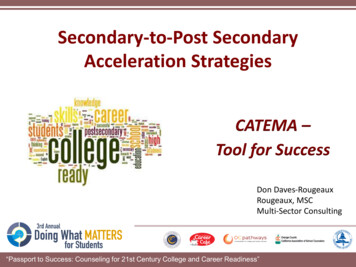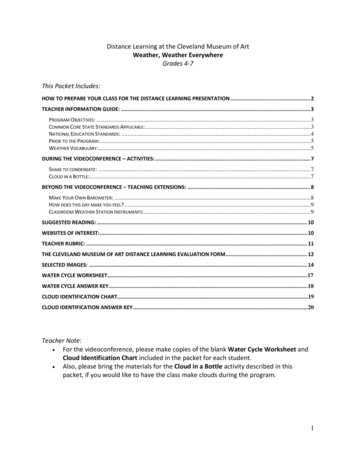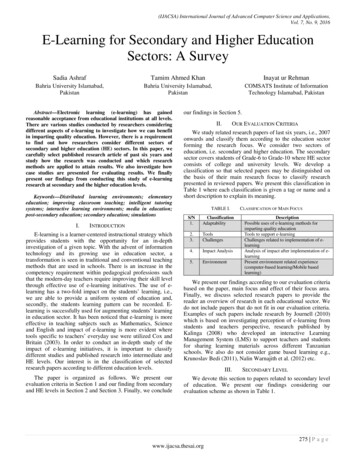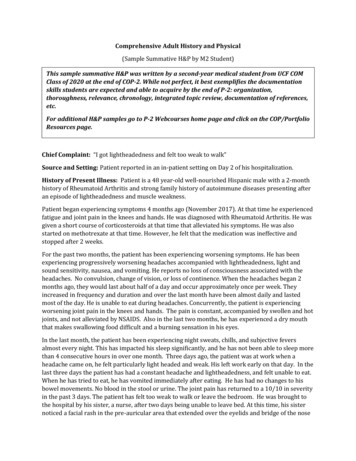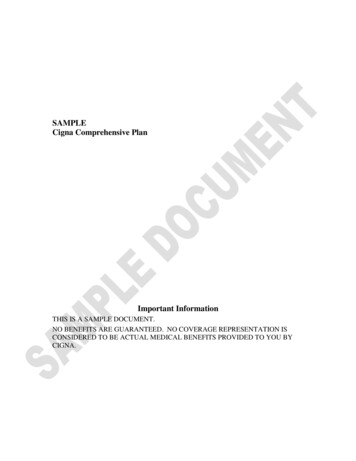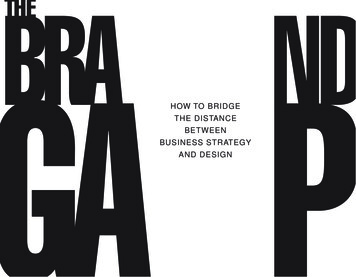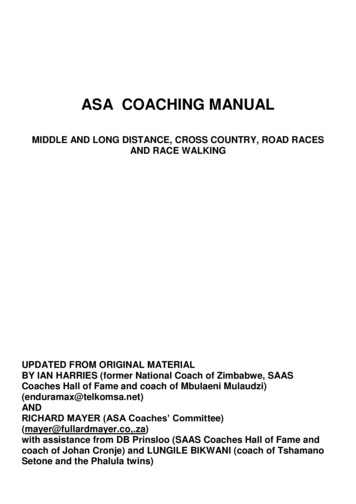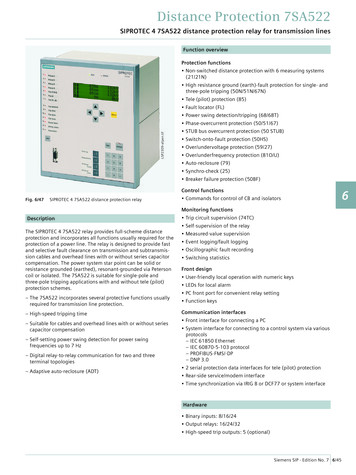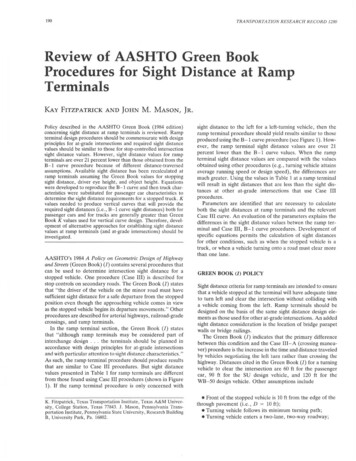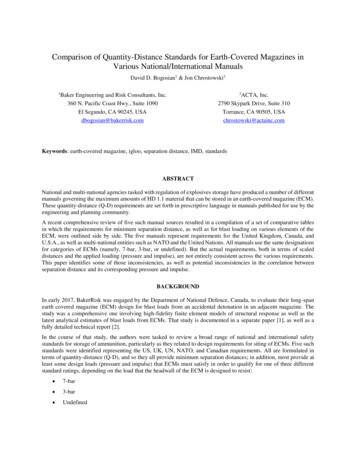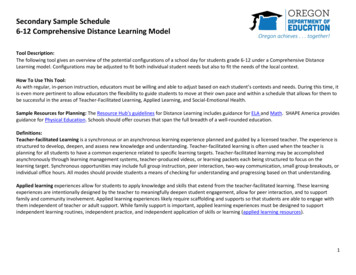
Transcription
Secondary Sample Schedule6-12 Comprehensive Distance Learning ModelTool Description:The following tool gives an overview of the potential configurations of a school day for students grade 6-12 under a Comprehensive DistanceLearning model. Configurations may be adjusted to fit both individual student needs but also to fit the needs of the local context.How To Use This Tool:As with regular, in-person instruction, educators must be willing and able to adjust based on each student’s contexts and needs. During this time, itis even more pertinent to allow educators the flexibility to guide students to move at their own pace and within a schedule that allows for them tobe successful in the areas of Teacher-Facilitated Learning, Applied Learning, and Social-Emotional Health.Sample Resources for Planning: The Resource Hub’s guidelines for Distance Learning includes guidance for ELA and Math. SHAPE America providesguidance for Physical Education. Schools should offer courses that span the full breadth of a well-rounded education.Definitions:Teacher-facilitated Learning is a synchronous or an asynchronous learning experience planned and guided by a licensed teacher. The experience isstructured to develop, deepen, and assess new knowledge and understanding. Teacher-facilitated learning is often used when the teacher isplanning for all students to have a common experience related to specific learning targets. Teacher-facilitated learning may be accomplishedasynchronously through learning management systems, teacher-produced videos, or learning packets each being structured to focus on thelearning target. Synchronous opportunities may include full group instruction, peer interaction, two-way communication, small group breakouts, orindividual office hours. All modes should provide students a means of checking for understanding and progressing based on that understanding.Applied learning experiences allow for students to apply knowledge and skills that extend from the teacher-facilitated learning. These learningexperiences are intentionally designed by the teacher to meaningfully deepen student engagement, allow for peer interaction, and to supportfamily and community involvement. Applied learning experiences likely require scaffolding and supports so that students are able to engage withthem independent of teacher or adult support. While family support is important, applied learning experiences must be designed to supportindependent learning routines, independent practice, and independent application of skills or learning (applied learning resources).1
Secondary Sample Schedule6-12 Comprehensive Distance Learning ModelSample Secondary Instructional Schedules*Additional time for college-level courses and laboratory experiences are allowed.Grade LevelTeacher- Facilitated Learning(Daily/Weekly)Must account for at least 50% ofInstructional TimeApplied LearningMust not account for more than 50% ofInstructional TimeNutrition and Wellness(snack, lunch, connect, time management, advisory)Does not count for Instructional Time6-82 hours, 30 minutes per day12 hours, 30 minutes per week(Required Minimum)Daily/weeklyNo Required MinimumDaily2 hours recommended9-112 hours, 50 minutes per day14 hours, 10 minutes per week(Required Minimum)Daily/weeklyNo Required MinimumDaily2 hours recommended12**2 hours, 45 minutes per day13 hours, 45 minutes per week(Required Minimum)Daily/weeklyNo Required MinimumDaily2 hours recommendedPlanning for Comprehensive Distance Instruction Ground content in relevant, culturally affirming, responsive and sustaining pedagogy.Develop daily/weekly plans aligned to Oregon content standards - focus on foundational and prioritized standards, principles ofUniversal Design for Learning (UDL), and backwards planning.Determine success criteria that students will need to demonstrate in class, small groups, or 1:1 to show their proficiency withessential standards.Explicitly discuss learning targets. Targets should connect to what students have previously learned, build on prior knowledge, andintegrate with other content areas.Plan to differentiate for student needs (students identified as TAG, students experiencing disabilities, emergent bilinguals, etc.).Create assessments and plan assessments that: are aligned with state content standards; have clear measurement criteria; measurestudent performance in more than two ways (e.g., in the form of a project, experiment, presentation, essay, short answer, or2
Secondary Sample Schedule6-12 Comprehensive Distance Learning Modelmultiple-choice test, performance); allow students to select from a menu of options; are portfolio-based; and are not reliant on astudent’s ability to use technology.Technology Planning Create training for students and families in use of online class tools and structures. Share and post class plans, weekly calendar, recorded lessons and resources with families and establish times for check-ins andconnections. Create a folder or homepage that is easy to access that includes learning materials, reference tools, student success criteria, andexemplars for students to reference. Storyboard your lessons, and post and present materials in the order students will need them to be successful. Record a video of thinking aloud through the skills and content (with visuals) that students may struggle with the most. Plan which interactive digital tools geared toward elementary will be most effective for the lesson (i.e., flipgrid, breakout rooms,videos, etc.). Determine how students will interact with stimuli (video, materials, text, etc.) to encourage different types of problem- solving(e.g., carefully constructed questions). Turn on closed captioning for videos to support student understanding and language development.Secondary: Sample Instructional Day / Week for a single courseTeacher-Facilitated LearningTimeMinimum:6-8: 2 hours, 30 minutes per day9-12: 2 hours, 50 minutes per dayApplied LearningCulturally Responsive, Mental, Social,Emotional HealthVariesIncorporate throughout all courses3
Secondary Sample Schedule6-12 Comprehensive Distance Learning ModelStrategiesEducators have the professionalskills to build life-long learning skillsand foster curiosity, creativity, andconnection. Virtual Instruction using districtLMS platform. Recorded videos Lessons can be found in thelearning management systems. Pace lesson to include directinstruction (use methods suchas 10:2) and time forprocessing, social interaction,checks for understanding. Meet with small groups ofstudents or one- on-one outsideof the whole group setting tosupport learning. Reference the learning targetthroughout the lesson. Model a think-aloud of newlearning and engage students inthe process. Show success criteria andreference throughout the lesson. Utilize frequent checks forunderstanding by stopping andasking questions and havingstudents put learning in their ownOpportunities to apply knowledge andskills builds mastery and criticalthinking. Encourage discussion with eachother and at home. Illustrate to create or demonstrate. Include summarizing and writing toenhance learning. Incorporate the use of commonhousehold materials. Inquiry to foster critical thinking. Encourage remote peer-to-peercollaboration. Provide clear directions andresponsibilities for group work. Utilize self-assessment and peerassessment tools with group work. Use checklists and rubrics as successcriteria to help students monitorprogress against expectations. Provide numerous times for studentsto engage in group activities todeepen their thinking and problemsolving skills. Assignments require students to: organize, interpret, analyze,synthesize, and evaluateLearning is possible and enhanced througha sense of community and connection. Maintain schedules and predictableroutines but be flexible. Honor the student environment,harnessing assets including homelanguage, family, and culture. Integrate culturally sustaining practices. Regularly brainstorm solutions, includingconflict resolution. Educator regularlycollects and incorporates student inputon class processes. Create a safe place to discuss fears,worries, triumphs, hopes. See National Equity Project: BuildingRapport.Reminder of social emotional supportsavailable The Oregon YouthLine: 877-968-8491(Text- Teen2Teen: 839863, EmailTeen2Teen@LinesforLife.org) The National Suicide Prevention Lifeline(English: 800-273-8255, Spanish: 888628-9454) Oregon 211: dial 211 or 866-698-6155(Text your zip code to 898211 or Emailhelp@211info.org)4
Secondary Sample Schedule6-12 Comprehensive Distance Learning Modelwords. Use small groups such asbreakout room options to workwith various groups of studentson differentiated needs. Engage students in chats andfeedback with attention topacing to ensure the purpose ismet.information rather than The SafeOregon Tip Line: 844-472-3367reproduce it;(Text- 844-472-3367, Email draw conclusions, maketip@safeoregon.com or download thegeneralizations, and producefree app)arguments that are supported The National Institute on Mentalthrough extended writing; andHealth’s child and teen coping strategies connect what they are learning tofor reducing stress related to traumaticexperiences, observations,events provides guidance for parentsfeelings, or situations significantand others supporting our students.in their daily lives, both inside The National Association of Schooland outside of school.Nurses and National Association ofSchool Psychologists developed aresource for how to talk with studentsabout COVID-19.Sample ScheduleTeacher FacilitatedApplied/Peer/Family/ CommunityLearningMonday: Assignments for the week areshared. Office hours with the teacher areannounced. Synchronous class and onlineresources are shared.Team projects: Students workcollaboratively to determine questions ordefine problems based on the projectparameters, determine and distributetasks, determine a schedule for completingMental, Social, Emotional HealthMonday: Connect with teachers; sharegratitudes/concerns from the week.Affirm that emotions like sadness, anxiety, fearand frustration are understandable, andencourage communication with trusted adultsand/or mental health professionals.5
Secondary Sample Schedule6-12 Comprehensive Distance Learning ModelThe teacher introduces a project, designchallenge, learning outcome, and/oressential questions.Feedback/support should be provided tostudents throughout the process asneeded.Teacher outlines standards/skill sets to becovered and performance expectations/success criteria.Additional materials (e.g. rubrics, videos,content support, etc.) should be includedat this time.Tuesday: Follow up with students whomight need more support to engage withthe learning. Try to contact students whoyou have not had success reaching.Wednesday: Offer office hours for checkins and provide additional resources tospur successful projects. Monitor studentchat. Synchronous check-in.Thursday: Feedback on student progressto date, office hours, peer discussionspacetasks, and provide opportunities for groupdiscussion.Tuesday-Thursday:peer / family / mentor connectionsIndividual project: The student determines Suggested mindful momentsquestions or problems to address withinSuggested physical activitythe parameters of the assigned project,determines steps toward completion of the Friday:project, and constructs a timeline forCheck in! How did the week go? Providecompletion. (Schedule regular check insopportunity for conversation about how thingswith teacher frequency will depend on the are going.students’ individual need for support.)Work-based Learning: Work-basedLearning is defined as structured learningin the workplace or simulated environmentthat provides opportunities for sustainedinteractions with industry or communityprofessionals that foster in-depth,firsthand experience of the expectationsand application of knowledge and skillsrequired in a given career field. Examplesinclude: Clinical/Practicum/Internships,School Based Enterprises, WorkplaceSimulation, Service-Learning andCooperative Work Experiences. Educatorscan create opportunities for students toalign work experiences that align to coursecurriculum and provide ongoinginteractions with business partners.6
Secondary Sample Schedule6-12 Comprehensive Distance Learning ModelFriday: Team/Individual project reflectionsubmitted to the teacher. Includequestions, concerns, successes, andchallenges. The teacher would use thesereflections the following week duringoffice hours to provide feedback tostudents. The teacher would use thisfeedback to determine additional ancillarysupport needed by individuals or studentsto support learning.7
Record a video of thinking aloud through the skills and content (with visuals) that students may struggle with the most. . 30 minutes per day . 9-12: 2 hours, 50 minutes per day Varies Incorporate throughout all courses . . Inquiry to foster critical thinki
